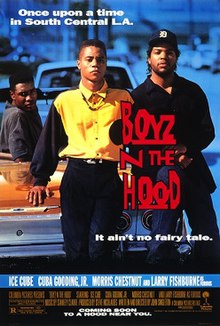
Back فتيان في الحي Arabic فتيان فى الحى ARZ Els nois del barri Catalan Boyz n the Hood Welsh Boyz n the Hood Danish Boyz n the Hood – Jungs im Viertel German Boyz n the Hood Spanish Boyz n the Hood Basque پسرا تو محله Persian Boyz n the Hood – kulman kundit Finnish
| Boyz n the Hood | |
|---|---|
 Theatrical release poster | |
| Directed by | John Singleton |
| Written by | John Singleton |
| Produced by | Steve Nicolaides |
| Starring | |
| Cinematography | Charles Mills |
| Edited by | Bruce Cannon |
| Music by | Stanley Clarke |
| Distributed by | Columbia Pictures |
Release dates |
|
Running time | 112 minutes |
| Country | United States |
| Language | English |
| Budget | $5.7–6.5 million[1][2] |
| Box office | $57.5 million[2] |
Boyz n the Hood is a 1991 American coming-of-age hood crime drama film written and directed by John Singleton in his feature directorial debut.[3] It stars Cuba Gooding Jr., Ice Cube (in his film debut), Morris Chestnut, and Laurence Fishburne (credited as Larry Fishburne), with Nia Long, Tyra Ferrell, Regina King, and Angela Bassett in supporting roles. Boyz n the Hood follows Jason "Tre" Styles III (Gooding Jr.), who is sent to live with his father Jason "Furious" Styles Jr. (Fishburne) in South Central Los Angeles, surrounded by the neighborhood's booming gang culture, where he reunites with his childhood friends. The film's title is a reference to the 1987 Eazy-E rap song of the same name, written by Ice Cube.
Singleton initially developed the film as a requirement for his application to film school in 1986 and sold the script to Columbia Pictures upon graduation in 1990. During writing, he drew inspiration from his own life and from the lives of people he knew and insisted he direct the project. Principal photography began in September 1990 and was filmed on location from October to November 1990. The film features breakout roles for Ice Cube, Gooding Jr., Chestnut, and Long.
Boyz n the Hood was screened in the Un Certain Regard section at the 1991 Cannes Film Festival.[4] It premiered in Los Angeles on July 2, 1991, and was theatrically released in the United States ten days later. The film became a critical and commercial success, grossing $57.5 million in North America and earning nominations for Best Director and Best Original Screenplay at the 64th Academy Awards. Singleton became the youngest person and the first African American to be nominated for Best Director. In 2002, the United States Library of Congress deemed it "culturally, historically, or aesthetically significant" and selected it for preservation in the National Film Registry.[5][6]
- ^ Cite error: The named reference
AFIwas invoked but never defined (see the help page). - ^ a b "Boyz N the Hood". Box Office Mojo. Retrieved January 19, 2015.
- ^ Cite error: The named reference
Guardianwas invoked but never defined (see the help page). - ^ "Boyz n the Hood". Festival de Cannes. Cannes Film Festival. Retrieved August 9, 2009.
- ^ "Complete National Film Registry Listing". National Film Preservation Board. Retrieved July 17, 2009.
- ^ "Librarian of Congress Adds 25 Films to National Film Registry". Library of Congress. Retrieved 2020-09-18.